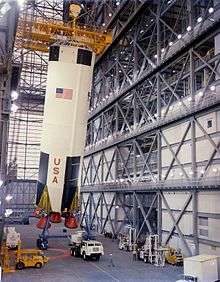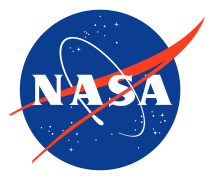Saturn V
Saturn V was an American super heavy-lift launch vehicle certified for human-rating used by NASA between 1967 and 1973. It consisted of three stages, each fueled by liquid propellants. It was developed to support the Apollo program for human exploration of the Moon and was later used to launch Skylab, the first American space station.
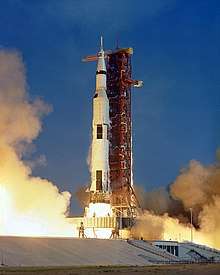 The launch of Apollo 11 on Saturn V SA-506, July 16, 1969 | |
| Function |
|
|---|---|
| Manufacturer | |
| Country of origin | United States |
| Project cost | $6.417 billion in 1964–1973 dollars[1] (~$49.9 billion in 2020 dollars) |
| Cost per launch | $185 million in 1969–1971 dollars[2] ($1.23 billion in 2019 value). |
| Size | |
| Height | 363.0 ft (110.6 m) |
| Diameter | 33.0 ft (10.1 m) |
| Mass | 6,540,000 lb (2,970,000 kg)[3] |
| Stages | 2–3 |
| Capacity | |
| Payload to LEO (90 nmi (170 km), 30° inclination) | 310,000 lb (140,000 kg)[4][5][note 1] |
| Payload to TLI | 107,100 lb (48,600 kg)[3] |
| Associated rockets | |
| Family | Saturn |
| Derivatives | Saturn INT-21 |
| Comparable |
|
| Launch history | |
| Status | Retired |
| Launch sites | LC-39, Kennedy Space Center |
| Total launches | 13 |
| Successes | 12 |
| Failures | 0 |
| Partial failures | 1 (Apollo 6) |
| First flight | November 9, 1967 (AS-501[note 2] Apollo 4) [6] |
| Last flight | May 14, 1973 (AS-513 Skylab) [7] |
| First stage – S-IC | |
| Length | 138.0 ft (42.1 m) |
| Diameter | 33.0 ft (10.1 m) |
| Empty mass | 287,000 lb (130,000 kg) |
| Gross mass | 5,040,000 lb (2,290,000 kg) |
| Engines | 5 Rocketdyne F-1 |
| Thrust | 7,891,000 lbf (35,100 kN) sea level |
| Specific impulse | 263 seconds (2.58 km/s) sea level |
| Burn time | 168 seconds |
| Fuel | RP-1 / LOX |
| Second stage – S-II | |
| Length | 81.5 ft (24.8 m) |
| Diameter | 33.0 ft (10.1 m) |
| Empty mass | 88,400 lb (40,100 kg)[note 3] |
| Gross mass | 1,093,900 lb (496,200 kg)[note 3] |
| Engines | 5 Rocketdyne J-2 |
| Thrust | 1,155,800 lbf (5,141 kN) vacuum |
| Specific impulse | 421 seconds (4.13 km/s) vacuum |
| Burn time | 360 seconds |
| Fuel | LH2 / LOX |
| Third stage – S-IVB | |
| Length | 61.6 ft (18.8 m) |
| Diameter | 21.7 ft (6.6 m) |
| Empty mass | 33,600 lb (15,200 kg)[8][note 4] |
| Gross mass | 271,000 lb (123,000 kg)[note 4] |
| Engines | 1 Rocketdyne J-2 |
| Thrust | 232,250 lbf (1,033.1 kN) vacuum |
| Specific impulse | 421 seconds (4.13 km/s) vacuum |
| Burn time | 165 + 335 seconds (2 burns) |
| Fuel | LH2 / LOX |
The Saturn V was launched 13 times from Kennedy Space Center with no loss of crew or payload. As of 2020, the Saturn V remains the tallest, heaviest, and most powerful (highest total impulse) rocket ever brought to operational status, and holds records for the heaviest payload launched and largest payload capacity to low Earth orbit (LEO) of 310,000 lb (140,000 kg), which included the third stage and unburned propellant needed to send the Apollo command and service module and Lunar Module to the Moon.
As the largest production model of the Saturn family of rockets, the Saturn V was designed under the direction of Wernher von Braun at the Marshall Space Flight Center in Huntsville, Alabama, with Boeing, North American Aviation, Douglas Aircraft Company, and IBM as the lead contractors.
To date, the Saturn V remains the only launch vehicle to carry humans beyond low Earth orbit. A total of 15 flight-capable vehicles were built, but only 13 were flown. An additional three vehicles were built for ground testing purposes. A total of 24 astronauts were launched to the Moon in the four years spanning December 1968 through December 1972.
History
In September 1945,[9] the US government brought the German rocket technologist Wernher von Braun and about seven hundred German rocket engineers and technicians to the United States for Operation Paperclip,[10][11] a program authorized by President Truman.[12]
Von Braun was assigned to the Army's rocket design division due to his prior direct involvement in the creation of the V-2 rocket.[13] Between 1945 and 1958, his work was restricted to conveying the ideas and methods behind the V-2 to American engineers.[14] Despite von Braun's many articles on the future of space rocketry,[15] the US government continued funding Air Force and Navy rocket programs to test their Vanguard missiles despite numerous costly failures.[16]
The US Army and government began taking serious steps towards sending Americans into space in 1957, when the Soviets launched Sputnik 1 atop an R-7 ICBM, which is capable of carrying a thermonuclear warhead to the US.[17][18][19] They turned to von Braun's team, who had created and experimented with the Jupiter series of rockets. [20]
The Juno I rocket launched the first American satellite in January 1958,[21] and was part of the last-ditch plan for NACA (the predecessor of NASA) to participate in the Space Race.[22] Von Braun considered the Jupiter series to be a prototype and referred to it as "an infant Saturn".[19]
Saturn development
The Saturn program was named for the next planet after Jupiter. Its design stemmed from the designs of the Jupiter series rockets. As the success of the Jupiter series became evident, the Saturn series emerged.[23] Between 1960 and 1962, the Marshall Space Flight Center (MSFC) designed a series of Saturn rockets that could be deployed for various Earth orbit or lunar missions.[24]
NASA planned to use the Saturn C-3 as part of the Earth orbit rendezvous (EOR) method, with at least four or five launches needed for a single lunar mission.[25]. However, the MSFC planned an even bigger rocket, the C-4, which would use four F-1 engines in its first stage, an enlarged C-3 second stage, and the S-IVB, a stage with a single J-2 engine, as its third stage. The C-4 would need only two launches to carry out an EOR lunar mission.[26]
On January 10, 1962, NASA announced plans to build the C-5. The three-stage rocket would consist of: the S-IC first stage, with five F-1 engines; the S-II second stage, with five J-2 engines; and the S-IVB third stage, with a single J-2 engine.[27] The C-5 was designed for a 90,000-pound (41,000 kg) payload capacity to the Moon.[27]
The C-5 would undergo component testing even before the first model was constructed. The S-IVB third stage would be used as the second stage for the C-IB, which would serve both to demonstrate proof of concept and feasibility for the C-5, but would also provide flight data critical to development of the C-5.[27] Rather than undergoing testing for each major component, the C-5 would be tested in an "all-up" fashion, meaning that the first test flight of the rocket would include complete versions of all three stages. By testing all components at once, far fewer test flights would be required before a crewed launch.[28]
The C-5 was confirmed as NASA's choice for the Apollo program in early 1963, and was named the Saturn V.[27] The C-1 became the Saturn I, and C-1B became Saturn IB. Von Braun headed a team at the MSFC to build a vehicle capable of launching a crewed spacecraft to the Moon.[19]
Before they moved under NASA's jurisdiction, von Braun's team had already begun work on improving the thrust, creating a less complex operating system, and designing better mechanical systems.[19] During these revisions, the team rejected the single engine of the V-2's design and moved to a multiple-engine design. The Saturn I and IB reflected these changes but were not large enough to send a crewed spacecraft to the Moon.[19] These designs, however, provided a basis for which NASA could determine its best method towards landing a man on the Moon.[19]
The Saturn V's final design had several key features. Engineers determined that the best engines were the F-1s coupled with the new liquid hydrogen propulsion system called J-2, which made the Saturn C-5 configuration optimal.[19] By 1962, NASA had finalized its plans to proceed with von Braun's Saturn designs, and the Apollo space program gained speed.[29]
With the configuration finalized, NASA turned its attention to mission profiles. Despite some controversy, a lunar orbit rendezvous for the lunar module was chosen over an Earth orbital rendezvous.[19] Issues such as type of fuel injections, the amount of fuel needed for the trip, and rocket manufacturing processes were resolved, and the designs for the Saturn V were selected. The stages were designed by von Braun's Marshall Space Flight Center in Huntsville, and outside contractors were chosen for the construction: Boeing (S-IC), North American Aviation (S-II), Douglas Aircraft (S-IVB), and IBM (instrument unit).[29]
Selection for Apollo lunar landing
Early in the planning process, NASA considered three methods for the Moon mission: Earth orbit rendezvous (EOR), direct ascent, and lunar orbit rendezvous (LOR). A direct ascent configuration would require an extremely large rocket to send a three-man spacecraft to land directly on the lunar surface. An EOR would launch the direct-landing spacecraft in two smaller parts which would combine in Earth orbit. A LOR mission would involve a single rocket launching two spacecraft: a mother ship, and a smaller, two-man landing module which would rendezvous back with the main spacecraft in lunar orbit. The lander would be discarded and the mother ship would return home.[30]
At first, NASA dismissed LOR as a riskier option, as a space rendezvous had yet to be performed in Earth orbit, much less in lunar orbit. Several NASA officials, including Langley Research Center engineer John Houbolt and NASA Administrator George Low, argued that a lunar orbit rendezvous provided the simplest landing on the Moon with the most cost–efficient launch vehicle, and the best chance to accomplish the lunar landing within the decade.[27] Other NASA officials were convinced, and LOR was officially selected as the mission configuration for the Apollo program on November 7, 1962.[27] Arthur Rudolph became the project director of the Saturn V rocket program in August 1963. He developed the requirements for the rocket system and the mission plan for the Apollo program. The first Saturn V launch lifted off from Kennedy Space Center and performed flawlessly on November 9, 1967, Rudolph's birthday.[31] He was then assigned as the special assistant to the director of MSFC in May 1968 and subsequently retired from NASA on January 1, 1969.[32] During his tenure he was awarded the NASA Exceptional Service Medal and the NASA Distinguished Service Medal. On July 16, 1969, the Saturn V launched Apollo 11, putting man on the Moon. [33]
Technology
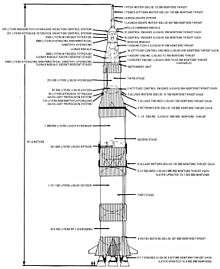
The Saturn V's size and payload capacity dwarfed all other previous rockets successfully flown at that time. With the Apollo spacecraft on top, it stood 363 feet (111 m) tall, and, ignoring the fins, was 33 feet (10 m) in diameter. Fully fueled, the Saturn V weighed 6.5 million pounds (2,900,000 kg)[3] and had a low Earth orbit payload capacity originally estimated at 261,000 pounds (118,000 kg), but was designed to send at least 90,000 pounds (41,000 kg) to the Moon.[34]
Later upgrades increased that capacity; during the final three Apollo lunar missions it deployed about 310,000 pounds (140,000 kg)[4][5][note 1] to LEO and sent up to 107,100 lb (48,600 kg)[3] spacecraft to the Moon. At a height of 363 feet (111 m), the Saturn V was 58 feet (18 m) taller than the Statue of Liberty from the ground to the torch, and 48 feet (15 m) taller than the Big Ben clock tower.[35]
In contrast, the Mercury-Redstone Launch Vehicle used on Freedom 7, the first crewed American spaceflight, was approximately 11 feet (3.4 m) longer than the S-IVB stage and delivered less sea level thrust (78,000 pounds-force (350 kN)) than the Launch Escape System rocket (150,000 pounds-force (667 kN) sea level thrust) mounted atop the Apollo command module.The Apollo LES fired for a much shorter time than the Mercury-Redstone (3.2 seconds vs. 143.5 seconds); thus the Redstone still delivered a much greater total impulse of 11,193,000 pounds (5,077,000 kg), versus 470,400 pounds (213,400 kg) for the Apollo LES.[36]
The Saturn V was principally designed by the Marshall Space Flight Center in Huntsville, Alabama, although numerous major systems, including propulsion, were designed by subcontractors. It used the powerful F-1 and J-2 rocket engines for propulsion, which shattered the windows of nearby houses when they were tested at Stennis Space Center.[37] Designers decided early on to attempt to use as much technology from the Saturn I program as possible. Consequently, the S-IVB-500 third stage of the Saturn V was based on the S-IVB-200 second stage of the Saturn IB. The instrument unit that controlled the Saturn V shared characteristics with the one carried by the Saturn IB.[38]
The Saturn V is primarily constructed by aluminum. It was also made of titanium, polyurethane, cork and asbestos.[39] Blueprints and other Saturn V plans are available on microfilm at the Marshall Space Flight Center.[40]
Stages
The Saturn V consisted of three stages—the S-IC first stage, S-II second stage and the S-IVB third stage—and the instrument unit. All three stages used liquid oxygen (LOX) as the oxidizer. The first stage used RP-1 for fuel, while the second and third stages used liquid hydrogen (LH2). Whereas LH2 has a much higher energy density to be lifted into orbit by mass, RP-1 has a much higher energy density by volume. Consequently, RP-1 was chosen for the first stage propellant because the volume of LH2 required would have been more than three times greater and would have created much higher aerodynamic drag during the boost phase through the atmosphere.[41] The upper stages also used small solid-propellant ullage motors that helped to separate the stages during the launch, and to ensure that the liquid propellants were in a proper position to be drawn into the pumps.[42]
S-IC first stage
The S-IC was built by the Boeing Company at the Michoud Assembly Facility, New Orleans, where the Space Shuttle external tanks would later be built by Lockheed Martin. Most of its mass at launch was propellant: RP-1 fuel with liquid oxygen as the oxidizer.[43] It was 138 feet (42 m) tall and 33 feet (10 m) in diameter, and provided over 7,600,000 pounds-force (34,000 kN) of thrust. The S-IC stage had a dry weight of about 289,000 pounds (131 metric tons); when fully fueled at launch, it had a total weight of 5,100,000 pounds (2,300 metric tons). It was powered by five Rocketdyne F-1 engines arrayed in a quincunx. The center engine was held in a fixed position, while the four outer engines could be hydraulically turned with gimbals to steer the rocket.[43] In flight, the center engine was turned off about 26 seconds earlier than the outboard engines to limit acceleration. During launch, the S-IC fired its engines for 168 seconds (ignition occurred about 8.9 seconds before liftoff) and at engine cutoff, the vehicle was at an altitude of about 36 nautical miles (67 km), was downrange about 50 nautical miles (93 km), and was moving about 7,500 feet per second (2,300 m/s).[44]
S-II second stage
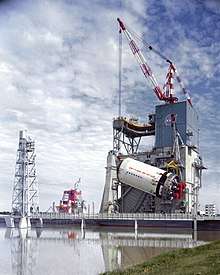
The S-II was built by North American Aviation at Seal Beach, California. Using liquid hydrogen and liquid oxygen, it had five Rocketdyne J-2 engines in a similar arrangement to the S-IC, also using the outer engines for control. The S-II was 81.6 feet (24.87 m) tall with a diameter of 33 feet (10 m), identical to the S-IC,[45][46] and thus was the largest cryogenic stage until the launch of the Space Shuttle in 1981. The S-II had a dry weight of about 80,000 pounds (36,000 kg); when fully fueled, it weighed 1,060,000 pounds (480,000 kg). The second stage accelerated the Saturn V through the upper atmosphere with 1,100,000 pounds-force (4,900 kN) of thrust in a vacuum.[47]
When loaded, significantly more than 90 percent of the mass of the stage was propellant; however, the ultra-lightweight design had led to two failures in structural testing. Instead of having an intertank structure to separate the two fuel tanks as was done in the S-IC, the S-II used a common bulkhead that was constructed from both the top of the LOX tank and bottom of the LH2 tank. It consisted of two aluminum sheets separated by a honeycomb structure made of phenolic resin.[48][49] This bulkhead had to insulate against the 126 °F (52 °C) temperature difference between the two tanks. The use of a common bulkhead saved 7,900 pounds (3.6 t) by both eliminating one bulkhead and reducing the stage's length.[50] Like the S-IC, the S-II was transported from its manufacturing plant to the Cape by sea. [51]
S-IVB third stage
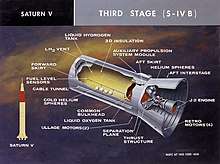
The S-IVB was built by the Douglas Aircraft Company at Huntington Beach, California. It had one J-2 engine and used the same fuel as the S-II. The S-IVB used a common bulkhead to separate the two tanks. It was 58.6 feet (17.86 m) tall with a diameter of 21.7 feet (6.604 m) and was also designed with high mass efficiency, though not quite as aggressively as the S-II. The S-IVB had a dry weight of about 23,000 pounds (10,000 kg) and, fully fueled, weighed about 262,000 pounds (119,000 kg).[52]
The S-IVB was the only rocket stage of the Saturn V small enough to be transported by Aero Spacelines Pregnant Guppy. [53]
Instrument unit
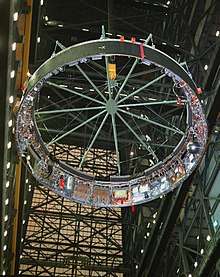
The instrument unit was built by IBM and was placed on top of the third stage. It was constructed at the Space Systems Center in Huntsville, Alabama. This computer controlled the operations of the rocket from just before liftoff until the S-IVB was discarded. It included guidance and telemetry systems for the rocket. By measuring the acceleration and vehicle attitude, it could calculate the position and velocity of the rocket and correct for any deviations.[54]
Range safety
In the event of an abort requiring the destruction of the rocket, the range safety officer would remotely shut down the engines and after several seconds send another command for the shaped explosive charges attached to the outer surfaces of the rocket to detonate. These would make cuts in fuel and oxidizer tanks to disperse the fuel quickly and to minimize mixing. The pause between these actions would give time for the crew to escape via the Launch Escape Tower or (in the later stages of the flight) the propulsion system of the Service module. A third command, "safe", was used after the S-IVB stage reached orbit to irreversibly deactivate the self-destruct system. The system was inactive as long as the rocket was still on the launch pad.[55]
Comparisons
Titan II
The Saturn V had a much lower thrust-to-weight ratio than Titan II GLV, the launch system used by Project Gemini, NASA's second human spaceflight program. Richard F. Gordon, Jr. described Saturn V as "an old man's ride", with "a lot more shake-rattle-and-roll" but milder thrust. Buzz Aldrin and other Apollo 11 astronauts agreed that unlike Titan, they could not tell when Saturn V liftoff occurred except from instruments.[56]
Soviet N1-L3
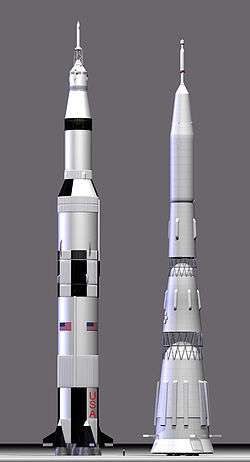
The Soviet space program's counterpart to the Saturn V was Sergei Korolev's N1-L3. The Saturn V was taller, heavier, and had a greater payload capacity, both to low Earth orbit and to translunar injection.[57] The N-1 was a three-stage launch vehicle with more liftoff thrust and a larger first stage diameter than the Saturn V. It was to carry the 209,000 lb (95,000 kg) L3 vehicle into orbit.[58][59]
The N1 never became operational; each of its four test launches resulted in catastrophic vehicle failure early in flight, and the program was canceled.[60] Korolev elected to cluster 30 relatively small engines for the first stage, rather than develop a large engine like the Rocketdyne F-1.[61]
The three-stage Saturn V grew over its lifetime to a peak thrust of at least 7,650,000 lbf (34,020 kN) (AS-510 and subsequent)[62] and a lift capacity of 310,000 lb (140,000 kg) to LEO. The AS-510 mission (Apollo 15) had a liftoff thrust of 7,823,000 lbf (34,800 kN). The AS-513 mission (Skylab 1) had slightly greater liftoff thrust of 7,891,000 lbf (35,100 kN). By comparison, the N-1 had a sea-level liftoff thrust of about 10,200,000 lbf (45,400 kN).[63] No other operational launch vehicle has surpassed the Saturn V in height, weight, total impulse, or payload capability. The closest contenders were the US Space Shuttle, the Soviet Energia, and the Falcon Heavy vehicle, manufactured by SpaceX. [64][65]
| Saturn V (Apollo 11)[66] | N1-L3 | |
|---|---|---|
| Diameter, maximum | 33 ft (10 m) | 56 ft (17 m) |
| Height w/ payload | 363 ft (111 m) | 344 ft (105 m) |
| Gross weight | 6,478,000 lb (2,938 t) | 6,030,000 lb (2,735 t) |
| First stage | S-IC | Block A |
| Thrust, SL | 7,500,000 lbf (33,000 kN) | 10,200,000 lbf (45,400 kN) |
| Burn time, s | 168 | 125 |
| Second stage | S-II | Block B |
| Thrust, vac | 1,155,800 lbf (5,141 kN) | 3,160,000 lbf (14,040 kN) |
| Burn time, s | 384 | 120 |
| Orbital insertion stage | S-IVB (burn 1) | Block V |
| Thrust, vac | 202,600 lbf (901 kN) | 360,000 lbf (1,610 kN) |
| Burn time, s | 147 | 370 |
| Total impulse[67] | 1.7336×109 lbf (7.711×106 kN)·s | 1.789×109 lbf (7.956×106 kN)·s |
| Orbital payload | 264,900 lb (120.2 t)[68] | 209,000 lb (95 t) |
| Injection velocity | 25,568 ft/s (7,793 m/s) | 25,570 ft/s (7,793 m/s)[69] |
| Payload momentum | 2.105×108 slug-ft/s (9.363×108 kg·m/s) | 1.6644×108 slug-ft/s (7.403×108 kg·m/s) |
| Propulsive efficiency | 12.14% | 9.31% |
| Earth departure stage | S-IVB (burn 2) | Block G |
| Thrust, vac | 201,100 lbf (895 kN) | 100,000 lbf (446 kN) |
| Burn time, s | 347 | 443 |
| Total impulse[67] | 1.8034×109 lbf (8.022×106 kN)·s | 1.833×109 lbf (8.153×106 kN)·s |
| Translunar payload | 100,740 lb (45.69 t) | 52,000 lb (23.5 t) |
| Injection velocity | 35,545 ft/s (10,834 m/s) | 35,540 ft/s (10,834 m/s)[69] |
| Payload momentum | 1.1129×108 slug-ft/s (4.95×108 kg·m/s) | 5.724×107 slug-ft/s (2.546×108 kg·m/s) |
| Propulsive efficiency | 6.17% | 3.12% |
U.S. Space Shuttle
The Space Shuttle generated a peak thrust of 6,800,000 lbf (30,100 kN),[70] and payload capacity to LEO (excluding the Orbiter itself) was 63,500 pounds (28,800 kg), which was about 25 percent of the Saturn V's payload. Its total mass in orbit, including the Orbiter, was about 247,000 lb (112,000 kg), compared to the Apollo 15 total orbital mass of the S-IVB third stage and Apollo spacecraft's 309,771 lb (140,510 kg), some 62,800 lb (28,500 kg) heavier than the Shuttle was rated to carry to LEO.[71]
Soviet Energia/Buran
Energia had a liftoff thrust of 7,826,000 lbf (34,810 kN).[72] It flew twice in 1987 and 1988, the second time as the launcher for the Buran spacecraft. However, both the Energia and Buran programs were canceled in 1993. Hypothetical future versions of Energia might have been significantly more powerful than the Saturn V, delivering 10,000,000 lbf (46,000 kN) of thrust and being able to deliver up to 386,000 lb (175 t) to LEO in the "Vulkan" configuration. Planned uprated versions of the Saturn V using F-1A engines would have had about 18 percent more thrust and 302,580 pounds (137,250 kg) payload.[73] NASA contemplated building larger members of the Saturn family, such as the Saturn C-8, and also unrelated rockets, such as Nova, but these were never produced.[74]
Space Launch System
NASA's Space Launch System, planned for its maiden flight in 2021,[75] is planned to be 400 feet (120 m) tall with payload in its final configuration, and lift up to 290,000 pounds (130,000 kg) into low Earth orbit.[76]
Other vehicles
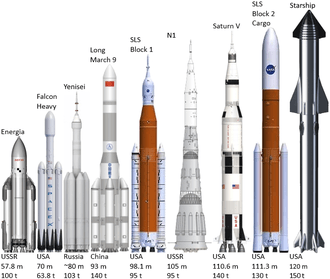
Some other recent US launch vehicles have significantly lower launch capacity to LEO than Saturn V: the US Delta IV Heavy's capacity is 63,470 lb (28,790 kg),[77] the Atlas V 551 has a capacity of 41,478 lb (18,814 kg),[78] and the Falcon Heavy vehicle, manufactured by SpaceX, has the maximum payload capacity of 140,700 lb (63,800 kg).[79] The European Ariane 5 ES delivers up to 46,000 lb (21,000 kg)[80] and the Russian Proton-M can launch 51,000 lb (23,000 kg).[81]
Assembly
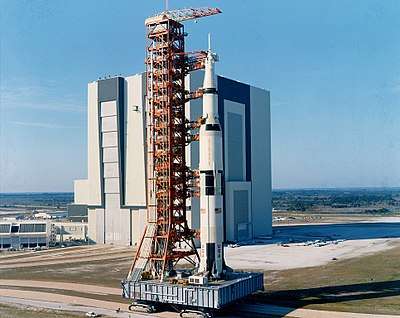
After the construction and ground testing of a stage was completed, it was shipped to the Kennedy Space Center. The first two stages were so massive that the only way to transport them was by barge. The S-IC, constructed in New Orleans, was transported down the Mississippi River to the Gulf of Mexico.[82]
After rounding Florida, the stages were transported up the Intra-Coastal Waterway to the Vehicle Assembly Building (originally called the Vertical Assembly Building). This was essentially the same route which would be used later by to ship Space Shuttle external tanks. The S-II was constructed in California and traveled to Florida via the Panama Canal. The third stage and Instrument Unit could be carried by the Aero Spacelines Pregnant Guppy and Super Guppy, but could also have been carried by barge if warranted.[82]
Upon arrival at the Vertical Assembly Building, each stage was inspected in a horizontal position before being oriented vertically. NASA also constructed large spool-shaped structures that could be used in place of stages if a particular stage was delayed. These spools had the same height and mass and contained the same electrical connections as the actual stages.[82]
NASA stacked (assembled) the Saturn V on a Mobile Launcher (ML), which consisted of a Launch Umbilical Tower (LUT) with nine swing arms (including the crew access arm), a "hammerhead" crane, and a water suppression system which was activated prior to launch. After assembly was completed, the entire stack was moved from the Vehicle Assembly Building (VAB) to the launch pad using the Crawler Transporter (CT). Built by the Marion Power Shovel Company (and later used for transporting the smaller and lighter Space Shuttle), the CT ran on four double-tracked treads, each with 57 "shoes". Each shoe weighed 2,000 pounds (910 kg). This transporter was also required to keep the rocket level as it traveled the 3 miles (4.8 km) to the launch site, especially at the 3 percent grade encountered at the launch pad. The CT also carried the Mobile Service Structure (MSS), which allowed technicians access to the rocket until eight hours before launch, when it was moved to the "halfway" point on the Crawlerway (the junction between the VAB and the two launch pads).[82]
Lunar mission launch sequence
The Saturn V carried all Apollo lunar missions,[83] which were launched from Launch Complex 39 at the John F. Kennedy Space Center in Florida.[84] After the rocket cleared the launch tower, flight control transferred to Mission Control at the Johnson Space Center in Houston, Texas.[85]
An average mission used the rocket for a total of just 20 minutes. Although Apollo 6 experienced three engine failures,[86] and Apollo 13 one engine shutdown,[87] the onboard computers were able to compensate by burning the remaining engines longer to achieve parking orbit.[88]
S-IC sequence
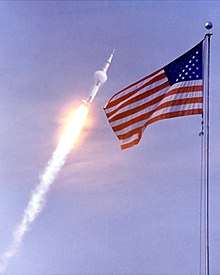
The first stage burned for about 2 minutes and 41 seconds, lifting the rocket to an altitude of 42 miles (68 km) and a speed of 6,164 miles per hour (2,756 m/s) and burning 4,700,000 pounds (2,100,000 kg) of propellant.[89]
At 8.9 seconds before launch, the first stage ignition sequence started. The center engine ignited first, followed by opposing outboard pairs at 300-millisecond intervals to reduce the structural loads on the rocket. When thrust had been confirmed by the onboard computers, the rocket was "soft-released" in two stages: first, the hold-down arms released the rocket, and second, as the rocket began to accelerate upwards, it was slowed by tapered metal pins pulled through dies for half a second.[90]
Once the rocket had lifted off, it could not safely settle back down onto the pad if the engines failed. The astronauts considered this one of the tensest moments in riding the Saturn V, for if the rocket did fail to lift off after release they had a low chance of survival given the large amounts of propellant. A fully fueled Saturn V exploding on the pad would have released the energy equivalent of 2 kilotons of TNT (8.4 TJ). To improve safety, the Saturn Emergency Detection System (EDS) inhibited engine shutdown for the first 30 seconds of flight. (See Saturn V Instrument Unit)[90]
It took about 12 seconds for the rocket to clear the tower. During this time, it yawed 1.25 degrees away from the tower to ensure adequate clearance despite adverse winds; this yaw, although small, can be seen in launch photos taken from the east or west. At an altitude of 430 feet (130 m) the rocket rolled to the correct flight azimuth and then gradually pitched down until 38 seconds after second stage ignition. This pitch program was set according to the prevailing winds during the launch month.[90]
The four outboard engines also tilted toward the outside so that in the event of a premature outboard engine shutdown the remaining engines would thrust through the rocket's center of mass. The Saturn V reached 400 feet per second (120 m/s) at over 1 mile (1,600 m) in altitude. Much of the early portion of the flight was spent gaining altitude, with the required velocity coming later. The Saturn V broke the sound barrier at just over 1 minute at an altitude of between 3 and 4 nautical miles (5.6 and 7.4 km). At this point, shock collars, or condensation clouds, would form around the bottom of the command module and around the top of the second stage.[90]
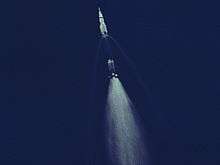
At about 80 seconds, the rocket experienced maximum dynamic pressure (max q). The dynamic pressure on a rocket varies with air density and the square of relative velocity. Although velocity continues to increase, air density decreases so quickly with altitude that dynamic pressure falls below max q.[90]
Acceleration increased during S-IC flight for three reasons. First, increased acceleration increased the propellant pressure at the engines, increasing the flow rate somewhat. This was the least important factor, though this feedback effect often led to an undesirable thrust oscillation called pogo. Second, as it climbed into thinner air F-1 engine efficiency increased significantly, a property of all rockets. The combined thrust of five engines on the pad was about 7.5 million pounds-force (33 MN), reaching nearly 9 million pounds-force (40 MN) at altitude. Third, and most importantly, the rocket's mass rapidly decreased.[90]
The propellant in just the S-IC made up about three-quarters of Saturn V's entire launch mass, and it was consumed at 13 metric tons per second (1,700,000 lb/min). Newton's second law of motion states that force is equal to mass multiplied by acceleration, or equivalently that acceleration is equal to force divided by mass, so as the mass decreased (and the force increased somewhat), acceleration rose. Including gravity, launch acceleration was only 1 1⁄4 g, i.e., the astronauts felt 1 1⁄4 g while the rocket accelerated vertically at 1⁄4 g. As the rocket rapidly lost mass, total acceleration including gravity increased to nearly 4 g at T+135 seconds. At this point, the inboard (center) engine was shut down to prevent acceleration from increasing beyond 4 g.[90]
When oxidizer or fuel depletion was sensed in the suction assemblies, the remaining four outboard engines were shut down. First stage separation occurred a little less than one second after this to allow for F-1 thrust tail-off. Eight small solid fuel separation motors backed the S-IC from the rest of the vehicle at an altitude of about 42 miles (67 km). The first stage continued ballistically to an altitude of about 68 miles (109 km) and then fell in the Atlantic Ocean about 350 miles (560 km) downrange.[90]
The engine shutdown procedure was changed for the launch of Skylab to avoid damage to the Apollo Telescope Mount. Rather than shutting down all four outboard engines at once, they were shut down two at a time with a delay to reduce peak acceleration further.[90]
S-II sequence
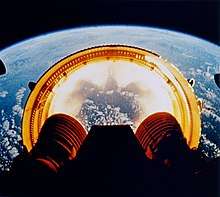
After S-IC separation, the S-II second stage burned for 6 minutes and propelled the craft to 109 miles (175 km) and 15,647 mph (25,181 km/h), close to orbital velocity.[91]
For the first two uncrewed launches, eight solid-fuel ullage motors ignited for four seconds to accelerate the S-II stage, followed by the ignition of the five J-2 engines. For the first seven crewed Apollo missions only four ullage motors were used on the S-II, and they were eliminated completely for the final four launches. About 30 seconds after first stage separation, the interstage ring dropped from the second stage. This was done with an inertially fixed attitude—orientation around its center of gravity—so that the interstage, only 3 feet 3 inches (1 m) from the outboard J-2 engines, would fall cleanly without hitting them, as the interstage could have potentially damaged two of the J-2 engines if it was attached to the S-IC. Shortly after interstage separation the Launch Escape System was also jettisoned .[91]
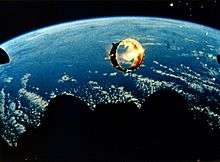
About 38 seconds after the second stage ignition the Saturn V switched from a preprogrammed trajectory to a "closed loop" or Iterative Guidance Mode. The instrument unit now computed in real time the most fuel-efficient trajectory toward its target orbit. If the instrument unit failed, the crew could switch control of the Saturn to the command module's computer, take manual control, or abort the flight.[91]
About 90 seconds before the second stage cutoff, the center engine shut down to reduce longitudinal pogo oscillations. At around this time, the LOX flow rate decreased, changing the mix ratio of the two propellants and ensuring that there would be as little propellant as possible left in the tanks at the end of second stage flight. This was done at a predetermined delta-v.[91]
Five level sensors in the bottom of each S-II propellant tank were armed during S-II flight, allowing any two to trigger S-II cutoff and staging when they were uncovered. One second after the second stage cut off it separated and several seconds later the third stage ignited. Solid fuel retro-rockets mounted on the interstage at the top of the S-II fired to back it away from the S-IVB. The S-II impacted about 2,300 nautical miles (4,200 km) from the launch site.[91]
On the Apollo 13 mission, the inboard engine suffered from major pogo oscillation, resulting in an early automatic cutoff. To ensure sufficient velocity was reached, the remaining four engines were kept active for longer than planned. A pogo suppressor was fitted to later Apollo missions to avoid this, though the early engine 5 cutoff remained to reduce g-forces.[87]
S-IVB sequence
Unlike the two-plane separation of the S-IC and S-II, the S-II and S-IVB stages separated with a single step. Although it was constructed as part of the third stage, the interstage remained attached to the second stage.[8]
During Apollo 11, a typical lunar mission, the third stage burned for about 2.5 minutes until first cutoff at 11 minutes 40 seconds. At this point it was 1,430 nautical miles (2,650 km) downrange and in a parking orbit at an altitude of 103.2 nautical miles (191.1 km) and velocity of 17,432 miles per hour (28,054 km/h). The third stage remained attached to the spacecraft while it orbited the Earth one and a half times while astronauts and mission controllers prepared for translunar injection (TLI).[8]
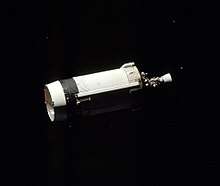
This parking orbit was quite low by Earth orbit standards, and it would have been short-lived due to aerodynamic drag. This was not a problem on a lunar mission because of the short stay in the parking orbit. The S-IVB also continued to thrust at a low level by venting gaseous hydrogen, to keep propellants settled in their tanks and prevent gaseous cavities from forming in propellant feed lines. This venting also maintained safe pressures as liquid hydrogen boiled off in the fuel tank. This venting thrust easily exceeded aerodynamic drag.
For the final three Apollo flights, the temporary parking orbit was even lower (approximately 93 nautical miles or 172 kilometers), to increase payload for these missions. The Apollo 9 Earth orbit mission was launched into the nominal orbit consistent with Apollo 11, but the spacecraft were able to use their own engines to raise the perigee high enough to sustain the 10-day mission. The Skylab was launched into a quite different orbit, with a 270-mile (434 km) perigee which sustained it for six years, and also a higher inclination to the equator (50 degrees versus 32.5 degrees for Apollo).[8]
On Apollo 11, TLI came at 2 hours and 44 minutes after launch. The S-IVB burned for almost six minutes giving the spacecraft a velocity close to the Earth's escape velocity of 25,053 mph (40,319 km/h). This gave an energy-efficient transfer to lunar orbit, with the Moon helping to capture the spacecraft with a minimum of CSM fuel consumption.[8]
About 40 minutes after TLI the Apollo command and service module (CSM) separated from the third stage, turned 180 degrees, and docked with the Lunar Module (LM) that rode below the CSM during launch. The CSM and LM separated from the spent third stage 50 minutes later. This process is known as Transposition, docking, and extraction.[8]
If it were to remain on the same trajectory as the spacecraft, the S-IVB could have presented a collision hazard so its remaining propellants were vented and the auxiliary propulsion system fired to move it away. For lunar missions before Apollo 13, the S-IVB was directed toward the Moon's trailing edge in its orbit so that the Moon would slingshot it beyond earth escape velocity and into solar orbit. From Apollo 13 onwards, controllers directed the S-IVB to hit the Moon.[92] Seismometers left behind by previous missions detected the impacts, and the information helped map the internal structure of the Moon.[93]
On September 3, 2002, astronomer Bill Yeung discovered a suspected asteroid, which was given the discovery designation J002E3. It appeared to be in orbit around the Earth, and was soon discovered from spectral analysis to be covered in white titanium dioxide, which was a major constituent of the paint used on the Saturn V. Calculation of orbital parameters led to tentative identification as being the Apollo 12 S-IVB stage.[94] Mission controllers had planned to send Apollo 12's S-IVB into solar orbit after separating from the Apollo spacecraft, but it is believed the burn lasted too long, and hence did not send it close enough to the Moon, remaining in a barely stable orbit around the Earth and Moon. In 1971, through a series of gravitational perturbations, it is believed to have entered in a solar orbit and then returned into weakly captured Earth orbit 31 years later. It left Earth orbit again in June 2003.[95]
Skylab
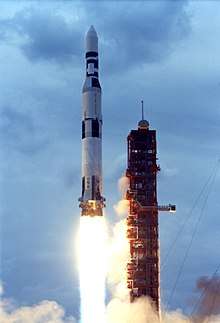
In 1965, the Apollo Applications Program (AAP) was created to look into science missions that could be performed using Apollo hardware. Much of the planning centered on the idea of a space station. Wernher von Braun's earlier (1964) plans employed a "wet workshop" concept, with a spent S-II Saturn V second stage being launched into orbit and outfitted in space. The next year AAP studied a smaller station using the Saturn IB second stage. By 1969, Apollo funding cuts eliminated the possibility of procuring more Apollo hardware, and in fact forced the cancellation of some later Moon landing flights. This freed up at least one Saturn V, allowing the wet workshop to be replaced with the "dry workshop" concept: the station (now known as Skylab) would be built on the ground from a surplus Saturn IB second stage and launched atop the first two live stages of a Saturn V.[96] A backup station, constructed from a Saturn V third stage, was built and is now on display at the National Air and Space Museum.[97]
Skylab was the only launch not directly related to the Apollo lunar landing program. The only significant changes to the Saturn V from the Apollo configurations involved some modification to the S-II to act as the terminal stage for inserting the Skylab payload into Earth orbit, and to vent excess propellant after engine cutoff so the spent stage would not rupture in orbit. The S-II remained in orbit for almost two years, and made an uncontrolled re-entry on January 11, 1975.[98]
Three crews lived aboard Skylab from May 25, 1973, to February 8, 1974.[99] Skylab remained in orbit until July 11, 1979.[100]
Proposed post-Apollo developments
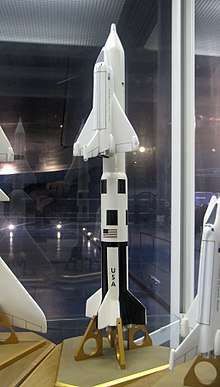
After Apollo, the Saturn V was planned to be the prime launch vehicle for Prospector, a proposed 330-kilogram (730 lb) robotic rover, to be launched to the Moon, similar to the Soviet Lunokhod rovers Lunokhod 1 and Lunokhod 2;[101] the Voyager Mars probes; and a scaled-up version of the Voyager interplanetary probes.[102] It was also to have been the launch vehicle for the nuclear rocket stage RIFT test program and the later NERVA.[103] All of these planned uses of the Saturn V were cancelled, with cost being a major factor. Edgar Cortright, who had been the director of NASA Langley, stated decades later that "JPL never liked the big approach. They always argued against it. I probably was the leading proponent in using the Saturn V, and I lost. Probably very wise that I lost."[102]
The canceled second production run of Saturn Vs would very likely have used the F-1A engine in its first stage, providing a substantial performance boost. Other likely changes would have been the removal of the fins (which turned out to provide little benefit when compared to their weight), a stretched S-IC first stage to support the more powerful F-1As, and uprated J-2s or an M-1 for the upper stages..[104]
A number of alternate Saturn vehicles were proposed based on the Saturn V, ranging from the Saturn INT-20 with an S-IVB stage and interstage mounted directly onto an S-IC stage, through to the Saturn V-23(L) which would not only have five F-1 engines in the first stage, but also four strap-on boosters with two F-1 engines each: giving a total of thirteen F-1 engines firing at launch.[105]
Lack of a second Saturn V production run killed this plan and left the United States without a super heavy-lift launch vehicle. Some in the U.S. space community came to lament this situation,[106] as continued production would have allowed the International Space Station, using a Skylab or Mir configuration with both U.S. and Russian docking ports, to be lifted with just a handful of launches. The Saturn-Shuttle concept also would have eliminated the Space Shuttle Solid Rocket Boosters that ultimately precipitated the Challenger accident in 1986.[107]
Cost
From 1964 until 1973, $6.417 billion (equivalent to $34.4 billion in 2018)[108] in total was appropriated for the Research and Development and flights of the Saturn V, with the maximum being in 1966 with $1.2 billion (equivalent to $7.24 billion in 2018).[1] That same year, NASA received its biggest budget of $4.5 billion, about 0.5 percent of the gross domestic product (GDP) of the United States at that time.[108]
Two of the largest reasons for the cancellation of the last three Apollo missions were the heavy investments in Saturn V and the Vietnam War continuing to require ever increasing amounts of money and resources from the U.S. In the time frame from 1969 to 1971 the cost of launching a Saturn V Apollo mission was between $185,000,000 to $189,000,000,[1][2] of which $110 million were used for the production of the vehicle[109] (equivalent to $992 million–$1.01 billion in 2018).[108]
Saturn V vehicles and launches
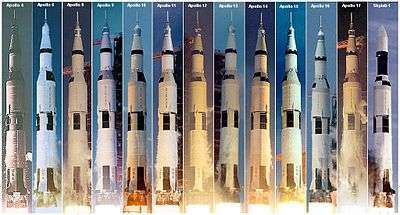
| Serial number[note 2] |
Mission | Launch date (UTC) |
Pad | Notes |
|---|---|---|---|---|
| SA-500F | Facilities integration | Used to check precise fits and test facilities operation on Pad 39A before a flight model was ready. First stage scrapped, second stage converted to S-II-F/D, third stage on display at Kennedy Space Center.[110] | ||
| SA-500D | Dynamic testing | Used to evaluate the vehicle's response to vibrations. On display at the U.S. Space & Rocket Center, Huntsville, Alabama.[110] | ||
| S-IC-T | All Systems Test | First stage used for static test firing at Marshall Space Flight Center. On display at Kennedy Space Center.[110] | ||
| SA-501 | Apollo 4 | November 9, 1967 12:00:01 |
39A | First uncrewed, all-up test flight; complete success. |
| SA-502 | Apollo 6 | April 4, 1968 12:00:01 |
39A | Second uncrewed test flight; J-2 engine problems caused early shutdown of two engines in second stage, and prevented third stage restart. |
| SA-503 | Apollo 8 | December 21, 1968 12:51:00 |
39A | First crewed flight; first trans-lunar injection of Apollo command and service module. |
| SA-504 | Apollo 9 | March 3, 1969 16:00:00 |
39A | Crewed low Earth orbit test of complete Apollo spacecraft with the Lunar Module (LM). |
| SA-505 | Apollo 10 | May 18, 1969 16:49:00 |
39B | Second crewed trans-lunar injection of complete Apollo spacecraft with LM; Only Saturn V launched from Pad 39B. |
| SA-506 | Apollo 11 | July 16, 1969 13:32:00 |
39A | First crewed lunar landing, at Sea of Tranquility. |
| SA-507 | Apollo 12 | November 14, 1969 16:22:00 |
39A | Vehicle was struck twice by lightning shortly after liftoff, no serious damage. Precision crewed lunar landing, near Surveyor 3 at Ocean of Storms. |
| SA-508 | Apollo 13 | April 11, 1970 19:13:03 |
39A | Severe pogo oscillations in second stage caused early center engine shutdown; guidance compensated by burning remaining engines longer. Third crewed lunar landing mission was aborted by service module failure. |
| SA-509 | Apollo 14 | January 31, 1971 21:03:02 |
39A | Third crewed lunar landing, near Fra Mauro, Apollo 13's intended landing site. |
| SA-510 | Apollo 15 | July 26, 1971 13:34:00 |
39A | Fourth crewed lunar landing, at Hadley–Apennine. First extended Apollo mission, carrying lunar orbital Scientific Instrument Module and Lunar Roving Vehicle. |
| SA-511 | Apollo 16 | April 16, 1972 17:54:00 |
39A | Fifth crewed lunar landing, at Descartes Highlands. |
| SA-512 | Apollo 17 | December 7, 1972 05:33:00 |
39A | Only night launch. Sixth and final crewed lunar landing, at Taurus–Littrow. |
| SA-513 | Skylab 1 | May 14, 1973 17:30:00 |
39A | Uncrewed launch of the Skylab orbital workshop, which replaced the third stage, S-IVB-513, on display at Johnson Space Center.[110] Originally designated for canceled Apollo 18. |
| SA-514 | Unused | Originally designated for canceled Apollo 19; never used. First stage (S-IC-14) on display at Johnson Space Center, second and third stage (S-II-14, S-IV-14) on display at Kennedy Space Center.[110] | ||
| SA-515 | Unused | Originally designated for Apollo 20, later as a backup Skylab launch vehicle; never used. The first stage was on display at Michoud Assembly Facility, until June 2016 then was moved to the INFINITY Science Center in Mississippi. The second stage (S-II-15) is on display at Johnson Space Center. The third stage was converted to a backup Skylab orbital workshop and is on display at the National Air and Space Museum.[110] | ||
Proposed successors
.png)
U.S. proposals for a rocket larger than the Saturn V from the late 1950s through the early 1980s were generally called Nova. Over thirty different large rocket proposals carried the Nova name, but none were developed.[74]
Wernher von Braun and others also had plans for a rocket that would have featured eight F-1 engines in its first stage, like the Saturn C-8, allowing a direct ascent flight to the Moon. Other plans for the Saturn V called for using a Centaur as an upper stage or adding strap-on boosters. These enhancements would have enabled the launch of large robotic spacecraft to the outer planets or send astronauts to Mars. Other Saturn V derivatives analyzed included the Saturn MLV family of "Modified Launch Vehicles", which would have almost doubled the payload lift capability of the standard Saturn V and were intended for use in a proposed mission to Mars by 1980.[111]
In 1968, Boeing studied another Saturn-V derivative, the Saturn C-5N, which included a nuclear thermal rocket engine for the third stage of the vehicle.[112] The Saturn C-5N would carry a considerably greater payload for interplanetary spaceflight. Work on the nuclear engines, along with all Saturn V ELVs, ended in 1973.[113][114]
The Comet HLLV was a massive heavy lift launch vehicle designed for the First Lunar Outpost program which was in the design phase from 1992–1993 under the Space Exploration Initiative. It was a Saturn V derived launch vehicle with over twice the payload capability and would have relied completely on existing technology. All of the engines were modernized versions of their Apollo counterparts and the fuel tanks would be stretched. Its main goal was to support the First Lunar Outpost program and future manned Mars missions. It was designed to be as cheap and easy to operate as possible.[115]
In 2006, as part of the proposed Constellation program, NASA unveiled plans to construct two Shuttle Derived Launch Vehicles, the Ares I and Ares V, which would use some existing Space Shuttle and Saturn V hardware and infrastructure. The two rockets were intended to increase safety by specializing each vehicle for different tasks, Ares I for crew launches and Ares V for cargo launches.[116] The original design of the heavy-lift Ares V, named in homage to the Saturn V, was 360 feet (110 m) in height and featured a core stage based on the Space Shuttle External Tank, with a diameter of 28 feet (8.4 m). It was to be powered by five RS-25s and two five-segment Space Shuttle Solid Rocket Boosters (SRBs). As the design evolved, the RS-25 engines were replaced with five RS-68 engines, the same engines used on the Delta IV. The switch from the RS-25 to the RS-68 was intended to reduce cost, as the latter was cheaper, simpler to manufacture, and more powerful than the RS-25, though the lower efficiency of the RS-68 required an increase in core stage diameter to 33 ft (10 m), the same diameter as the Saturn V's S-IC and S-II stages.[116]
In 2008, NASA again redesigned the Ares V, lengthening the core stage, adding a sixth RS-68 engine, and increasing the SRBs to 5.5 segments each.[117] This vehicle would have been 381 feet (116 m) tall and would have produced a total thrust of approximately 8,900,000 lbf (40 MN) at liftoff, more than the Saturn V or the Soviet Energia, but less than the Soviet N-1. Projected to place approximately 400,000 pounds (180 t) into orbit, the Ares V would have surpassed the Saturn V in payload capability. An upper stage, the Earth Departure Stage, would have utilized a more advanced version of the J-2 engine, the J-2X. Ares V would have placed the Altair lunar landing vehicle into low Earth orbit. An Orion crew vehicle launched on Ares I would have docked with Altair, and the Earth Departure Stage would then send the combined stack to the Moon.[118]
After the cancellation of the Constellation program – and hence Ares I and Ares V – NASA announced the Space Launch System (SLS) heavy-lift launch vehicle for beyond low Earth orbit space exploration.[119] The SLS, similar to the original Ares V concept, will be powered by four RS-25 engines and two five-segment SRBs. Its Block 1 configuration will lift approximately 209,000 pounds (95 t) to LEO. Block 1B will add the Exploration Upper Stage, powered by four RL10 engines, to increase payload capacity. An eventual Block 2 variant will upgrade to advanced boosters, increasing LEO payload to at least 290,000 pounds (130 t).[120]
One proposal for advanced boosters would use a derivative of the Saturn V's F-1, the F-1B, and increase SLS payload to around 330,000 pounds (150 t) to LEO.[121] The F-1B is to have better specific impulse and be cheaper than the F-1, with a simplified combustion chamber and fewer engine parts, while producing 1,800,000 lbf (8.0 MN) of thrust at sea level, an increase over the approximate 1,550,000 lbf (6.9 MN) achieved by the mature Apollo 15 F-1 engine,[122]
NASA SLS deputy project manager Jody Singer of the Marshall Space Flight Center in Huntsville, in 2012 stated that the vehicle will have a launch cost of approximately $500 million per launch, with a relatively minor dependence of costs on launch capability.[123]
Saturn V displays
- Two at the U.S. Space & Rocket Center in Huntsville:
- SA-500D is on horizontal display made up of its S-IC-D, S-II-F/D and S-IVB-D. These were all test stages not meant for flight. This vehicle was displayed outdoors from 1969 to 2007, was restored, and is now displayed in the Davidson Center for Space Exploration.
- Vertical display (replica) built in 1999 located in an adjacent area.[124]
- One at the Johnson Space Center made up of the first stage from SA-514, the second stage from SA-515, and the third stage from SA-513 (replaced for flight by the Skylab workshop). With stages arriving between 1977 and 1979, this was displayed in the open until its 2005 restoration when a structure was built around it for protection. This is the only display Saturn consisting entirely of stages intended to be launched.[125]
- One at the Kennedy Space Center Visitor Complex, made up of S-IC-T (test stage) and the second and third stages from SA-514.[126] It was displayed outdoors for decades, then in 1996 was enclosed for protection from the elements in the Apollo/Saturn V Center.[127]
- The S-IC stage from SA-515 is on display at the Infinity Science Center in Mississippi.[128]
- The S-IVB stage from SA-515 was converted for use as a backup for Skylab, and is on display at the National Air and Space Museum in Washington, D.C.[129]
 Saturn V Rocket -- Johnson Space Center
Saturn V Rocket -- Johnson Space Center Saturn V's F-1 engines -- Rocket Park, Houston
Saturn V's F-1 engines -- Rocket Park, Houston
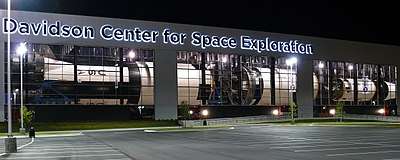 U.S. Space & Rocket Center
U.S. Space & Rocket Center Johnson Space Center
Johnson Space Center- Kennedy Space Center
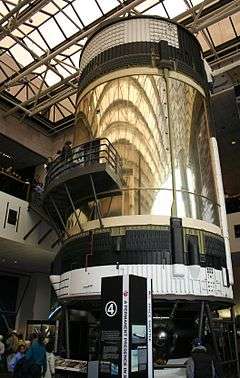 S-IVB stage as Skylab, National Air & Space Museum
S-IVB stage as Skylab, National Air & Space Museum
Media
Saturn V in fiction
Film footage of the Saturn V appears in the Star Trek TV episode "Assignment: Earth", originally broadcast on March 29, 1968. Saturn V and the Apollo program are not mentioned by name, but the rocket was used as a stand-in for the launching of a fictional "orbital nuclear warhead platform by the United States, countering a similar launch by other powers". Pre-launch footage comes from the unflown SA-500F Facilities Integration Vehicle (the only Saturn V with "USA" markings on the third stage) and Apollo 6 (the only Saturn V launched with a white service module), while launch footage comes from Apollo 4 (as the episode aired six days prior to the launch of Apollo 6, the second Saturn V launch.)[130]
See also
- Comparison of orbital launchers families
- Comparison of orbital launch systems
- Space exploration
- Comet HLLV (a Saturn derived launch vehicle design from the 90s)
References
- "Apollo Program Budget Appropriations". NASA. Retrieved January 16, 2008.
- "SP-4221 The Space Shuttle Decision- Chapter 6: Economics and the Shuttle". NASA. Retrieved January 15, 2011.
- "Ground Ignition Weights". NASA.gov. Retrieved November 8, 2014.
- Alternatives for Future U.S. Space-Launch Capabilities (PDF), The Congress of the United States. Congressional Budget Office, October 2006, p. 4 9
- Thomas P. Stafford (1991), America at the Threshold – Report of the Synthesis Group on America's Space Exploration Initiative, p. 31
- "APOLLO LAUNCHES". airandspace.si.edu. Retrieved July 24, 2020.
- "SATURN V LAUNCH VEHICLE FL'GHT EVALUATION REPORT -SA-513 SKYLAB 1" (PDF). nasa.gov. NASA. August 1, 1973. Retrieved July 21, 2020.
- "Third stage fact sheet" (PDF). Archived from the original (PDF) on December 21, 2005. Retrieved July 7, 2020.
- "Wernher von Braun". earthobservatory.nasa.gov. May 2, 2001. Retrieved July 23, 2020.
- Jacobsen, Annie (2014). Operation Paperclip: The Secret Intelligence Program to Bring Nazi Scientists to America. New York: Little, Brown and Company. p. Prologue, ix. ISBN 978-0-316-22105-4.
- "Joint Intelligence Objectives Agency". U.S. National Archives and Records Administration. Retrieved October 9, 2008.
- "MEMORANDUM". Letter to Members of the Advisory Committee on Human Radiation Experiments.CS1 maint: others (link)
- Neufeld, Michael J. (May 20, 2019). "Wernher von Braun and the Nazis". PBS. Retrieved July 23, 2020.
- "Wernher von Braun". earthobservatory.nasa.gov. May 2, 2001. Retrieved April 2, 2019.
- Harbaugh, Jennifer. "Biography of Wernher Von Braun". nasa.gov. NASA. Retrieved July 24, 2020.
- BBC, Future - Wernher von Braun's bold plan for space exploration, By Richard Hollingham, 16 December 2015
- Marov, Wesley T. Huntress, Mikhail Ya. The Soviet Robots in the Solar System. New York, NY: Gardners Books. p. 36. ISBN 1-4419-7897-6.
- "The Dawn of the Space Age". cia.gov.
- Roger E. Bilstein (1996). Stages to Saturn: A Technological History of the Apollo/Saturn Launch Vehicles. NASA SP-4206. ISBN 0-16-048909-1.
- "Reach for the Stars". TIME Magazine. February 17, 1958. Archived from the original on December 21, 2007.
- Boehm, J.; Fichtner, H.J.; Hoberg, Otto A. "EXPLORER SATELLITES LAUNCHED BY JUNO 1 AND JUNO 2 VEHICLES" (PDF). Astrionics Division George C. Marshall Space Flight Center National Aeronautics and Space Administration Huntsville, Alabama. p. 163. Retrieved July 24, 2020.
- Robin Williams. "Wernher von Braun (1912–1977)". NASA. Retrieved November 13, 2010.
- "Saturn the Giant by Wernher von Braun". history.msfc.nasa.gov. Retrieved April 3, 2019.
- Dunar, Andrew J.; U.S., National Aeronautics and Space Administration; Waring, Stephen P. (1999). Power to Explore A History of Marshall Space Flight Center, 1960-1990. National Aeronautics and Space Administration. p. 54. ISBN 9780160589928. Retrieved June 22, 2020.
- Benson, Charles D.; William Barnaby Faherty (1978). "4-8". Moonport: A History of Apollo Launch Facilities and Operations. NASA (SP-4204). Retrieved February 7, 2013.
- Space Flight: History, Technology, and Operations, By Lance K. Erickson, page 319
- Bilstein, Roger E. (1999). Stages to Saturn: A Technological History of the Apollo/Saturn Launch Vehicle. DIANE Publishing. pp. 59–61. ISBN 978-0-7881-8186-3. Retrieved February 4, 2008.
- Edgar M. Cortright, ed. (1975). "3.4". Apollo Expeditions to the Moon. NASA Langley Research Center. ISBN 978-9997398277. Retrieved February 11, 2008.
- "Saturn V Moon Rocket". Boeing. Archived from the original on November 20, 2010. Retrieved November 14, 2010.
- Edgar M. Cortright, ed. (1975). "3.2". Apollo Expeditions to the Moon. NASA Langley Research Center. ISBN 978-9997398277. Retrieved February 11, 2008.
- "Man in the News: Saturn 5 Coordinator". The New York Times. Nov. 11, 1967
- "Saturn Chief Leaving Post". The New York Times. May 15, 1968
- Loff, Sarah. "Apollo 11 Mission Overview". nasa.gov. NASA. Retrieved June 26, 2020.
- NASA,Saturn V Payload Planners Guide, November 1965.
- "Bong! Big Ben rings in its 150th anniversary". Associated Press. May 29, 2009. Retrieved June 1, 2009.
- Duncan, John (2002). "Apollo Spacecraft News Reference: Launch Escape System". The Apollo Saturn Reference Page.
- "Stennis Space Center Celebrates 40 Years of Rocket Engine Testing". NASA. April 20, 2006. Retrieved January 16, 2008.
- "SP-4206 Stages to Saturn". History.nasa.gov. Retrieved July 6, 2020.
- Streigel, Mary (July 1, 2015). "The Space Age In Construction". National Park Service. Retrieved October 4, 2019.
- Paine, Michael (March 13, 2000). "Saturn 5 Blueprints Safely in Storage". Space.com. Archived from the original on August 18, 2010. Retrieved November 9, 2011.
- Bilstein, Roger E. (1999). Stages to Saturn: A Technological History of the Apollo/Saturn Launch Vehicle. Diane Publishing. pp. 192. ISBN 9780788181863.
RP-1.
- "Rocket Motor, Solid Fuel, Ullage, Also Designated TX-280". Smithsonian. Retrieved December 4, 2018.
- Lennick, Michael (2006). Launch vehicles : heritage of the space race. Burlington, Ontario: Apogee Books. p. 46. ISBN 1-894959-28-0.
- NASA (1968). "Saturn V Flight Manual – SA-503" (PDF). NASA – George C. Marshall Space Flight Center. Retrieved March 28, 2015. § 4.
- Walker, Joel. "Saturn V Second Stage". nasa.gov. NASA. Retrieved July 6, 2020.
- "Second Stage, S-II-F/D, Saturn V Launch Vehicle, Dynamic Test Version". airandspace.si.edu. Smithsonian air and space museum. Retrieved July 6, 2020.
- "Second Stage Fact Sheet" (PDF). Archived from the original (pdf) on March 26, 2015. Retrieved September 23, 2014.
- "Second Stage, S-II-F/D, Saturn V Launch Vehicle, Dynamic Test Version". airandspace.si.edu. Smithsonian air and space museum. Retrieved July 6, 2020.
- "Second Stage Fact Sheet" (PDF). Archived from the original (pdf) on March 26, 2015. Retrieved September 23, 2014.
- "Second Stage Fact Sheet" (PDF). Archived from the original (pdf) on March 26, 2015. Retrieved September 23, 2014.
- "SP-4206 Stages to Saturn". history.nasa.gov. NASA. Retrieved July 7, 2020.
- "Saturn S-IVB". apollosaturn. Retrieved November 4, 2011.
- "SP-4206 Stages to Saturn". history.nasa.gov. NASA. Retrieved July 7, 2020.
- "NASA SPACE VEHICLE DESIGN CRITERIA (GUIDANCE AND CONTROL)" (PDF). ntrs.nasa.gov. NASA. Retrieved July 7, 2020.
- "Skylab Saturn IB Flight Manual" (PDF). NASA Marshall Spaceflight Center. Retrieved January 16, 2008.
- Agle, D. C. (September 1998). "Riding the Titan II". Air & Space.
- Wade, Mark. "Saturn V". Encyclopedia Astronautica. Archived from the original on October 7, 2011. Retrieved January 16, 2008.
- Wade, Mark. "N1". Encyclopedia Astronautica. Retrieved January 16, 2008.
- Harford, James (1997). Korolev: how one man masterminded the Soviet drive to beat America to the moon. New York; Chichester: Wiley. p. 271. ISBN 978-0-471-32721-9.
- "N1". Retrieved July 7, 2020.
- David, Leonard. "New Secrets of Huge Soviet Moon Rocket Revealed". Space.com. Retrieved July 7, 2020.
- "SP-4206 Stages to Saturn p405". NASA. Retrieved January 16, 2008.
- Seamans Jr, Robert. C. (2007). Project Apollo: The Tough Decisions (PDF). Washington, D.C.: NASA History Division – Government Printing Office. p. 120. ISBN 978-0-16-086710-1. Retrieved October 28, 2015.
- Malik, Tariq. "The World's Tallest Rockets: How They Stack Up". space.com. Retrieved July 7, 2020.
- Thomas, Rachael. "Super heavy-lift launch vehicles: How does Falcon Heavy stack up?". floridatoday.com. Retrieved July 7, 2020.
- Saturn V: Apollo 11 mission, in Orloff, Richard W (2001). Apollo By The Numbers: A Statistical Reference, "Launch Vehicle/Spacecraft Key Facts". NASA. in PDF format. Retrieved on 2008-02-19. Published by Government Reprints Press, 2001, ISBN 1-931641-00-5.
- Neglects first stage thrust increase with altitude
- Includes mass of Earth departure fuel
- Assumed identical to Saturn V value
- "Working Scenario" (PDF). Columbia Accident Investigation Board. Retrieved January 16, 2008.
- "Apollo 15 Press Kit" (PDF). Washington, D.C.: NASA. July 15, 1971. Release No: 71-119K. Archived from the original (PDF) on July 21, 2011. Retrieved July 14, 2011.
- Petrovitch, Vassili. "Description of the Energia launcher, its boosters, its central block, its engines". Buran-Energia. Vassili Petrovitch. Retrieved September 18, 2015.
- Wade, Mark. "Saturn MLV-V-1". Encyclopedia Astronautica. Retrieved January 16, 2008.
- "Nova". astronautix.com. Retrieved July 7, 2020.
- Berger, Eric (July 17, 2019). "NASA's large SLS rocket unlikely to fly before at least late 2021". Ars Technica. Retrieved August 28, 2019.
- "Space Launch System: NASA's Giant Rocket Explained (Infographic)".
- "Delta IV Launch Services User's Guide" (PDF). United Launch Alliance. October 14, 2013. pp. 2–10, 5–3. Archived (PDF) from the original on October 14, 2013. Retrieved July 6, 2020.
- "Atlas V Planner's Guide-March 2010" (PDF). Lockheed Martin. Archived from the original (PDF) on December 18, 2017.
- "Falcon Heavy". spacex.com. Retrieved July 7, 2020.
- "Ariane 5 ES". Retrieved July 7, 2020.
- "Proton Launch System Mission Planner's Guide" (PDF). Archived from the original (PDF) on January 29, 2012.
- Lawrie, Alan (2016). Saturn V Rocket. Arcadia Publishing. ISBN 9781439658628.
- Dunbar, Brian. "What Was the Saturn V?". nasa.gov. Retrieved July 7, 2020.
- "Launch Complex 39". nasa.gov. NASA. Retrieved July 7, 2020.
- "JSC History". nasa.gov. NASA. Retrieved July 7, 2020.
- "Saturn V Launch Vehicle Evaluation Report—AS-502 Apollo 6 Mission" (PDF).
- "NASA Technical Reports Server (NTRS)" (PDF). nasa.gov.
- "Saturn V Lauch Vehicle Fight Evaluation Report Apollo 6" (PDF). NASA. June 25, 1968. Retrieved July 7, 2020.
- Boeing History, Saturn V Moon Rocket, www.boeing.com/history/boeing/saturn.html
- "First Stage Fact Sheet" (PDF). Archived from the original (PDF) on December 21, 2005. Retrieved July 7, 2020.
- "Second Stage Fact Sheet" (PDF). Archived from the original (PDF) on March 26, 2015. Retrieved July 7, 2020.
- "NASA GSFC – Lunar Impact Sites". NASA. Retrieved January 16, 2008.
- "Apollo 11 Seismic Experiment". moon.nasa.gov. September 22, 2017.
- Chodas, Paul; Chesley, Steve (October 9, 2002). "J002E3: An Update". NASA. Retrieved September 18, 2013.
- Jorgensen, K.; Rivkin, A.; Binzel, R.; Whitely, R.; Hergenrother, C.; Chodas, P.; Chesley, S.; Vilas, F. (May 2003). "Observations of J002E3: Possible Discovery of an Apollo Rocket Body". Bulletin of the American Astronomical Society. 35: 981. Bibcode:2003DPS....35.3602J.
- Young, Anthony (2008). The Saturn V F-1 Engine: Powering Apollo into History. New York: Springer-Praxis. p. 245. ISBN 978-0-387-09629-2.
- David J. Shayler (2001). Skylab: America's Space Station. Springer Science & Business Media. p. 301. ISBN 978-1-85233-407-9.
- "Skylab rocket debris falls in Indian Ocean". Chicago Tribune. January 11, 1975. Retrieved October 22, 2014.
- "Skylab: First U.S. Space Station".
- "July 11, 1979: Look Out Below! Here Comes Skylab!". wired.com.
- Paolo Ulivi (2004). Lunar Exploration: Human Pioneers and Robotic Surveyors. Springer Science & Business Media. p. 40. ISBN 978-1-85233-746-9.
- "Cortright Oral History (p31)" (PDF). Archived from the original (PDF) on September 10, 2012. Retrieved January 26, 2012.
- http://www.astronautix.com/stages/satv25su.htm Saturn S-N engine intended to be used on the Saturn C-5N
- Wade, Mark. "Saturn Genealogy". Encyclopedia Astronautica. Retrieved January 17, 2008.
- Wade, Mark. "Saturn V-23(L)". Encyclopedia Astronautica. Retrieved January 16, 2008.
- "Human Space Exploration:The Next 50 Years". Aviation Week. March 14, 2007. Retrieved June 18, 2009.
- "Challenger STS 51-L Accident January 28, 1986". history.nasa.gov. NASA. Retrieved July 7, 2020.
- Thomas, Ryland; Williamson, Samuel H. (2019). "What Was the U.S. GDP Then?". MeasuringWorth. Retrieved April 6, 2019. United States Gross Domestic Product deflator figures follow the Measuring Worth series.
- "sp4206".
- Wright, Mike. "Three Saturn Vs on Display Teach Lessons in Space History". NASA. Retrieved February 10, 2011.
- https://ntrs.nasa.gov/archive/nasa/casi.ntrs.nasa.gov/19650020081_1965020081.pdf "Modified Launch Vehicle (MLV) Saturn V Improvement Study Composite Summary Report", NASA Marshall Space Flight Center (MSFC), July 1965, p. 76.
- "Saturn S-N V-25(S)U". Astronautix.com. Retrieved October 14, 2013.
- Dewar, James (2008). To The End Of The Solar System: The Story Of The Nuclear Rocket (2nd ed.). Apogee. ISBN 978-1-894959-68-1.
- NASA's Nuclear Frontier The Plum Brook Reactor Facility, pp. 68, 73, 76, 101, 116, 129.
- "First Lunar Outpost". www.astronautix.com. Retrieved January 10, 2020.
- John P. Sumrall A New Heavy-Lift Capability for Space Exploration: NASA's Ares V Cargo Launch Vehicle. NASA Through years of triumph and tragedy, direct experience and engineering risk analyses have concluded that separating the crew from the cargo during launch reduces safety risks and improves safety statistics.
- Phil Sumrall (August 15, 2008). "Ares V Overview" (PDF). p. 4 – Launch Vehicle Comparisons.
- "NASA's Ares Projects Ares V Cargo Launch Vehicle" (PDF). nasa.gov.
- David S. Weaver (September 14, 2011). "NASA SLS Announcement".
- "Space Launch System Core Stage" (PDF). nasa.gov.
- Chris Bergin (November 9, 2012). "Dynetics and PWR aiming to liquidize SLS booster competition with F-1 power". NASASpaceFlight.com. Retrieved October 14, 2013.
- Lee Hutchinson (April 15, 2013). "New F-1B rocket engine upgrades Apollo-era design with 1.8M lbs of thrust". Ars Technica. Retrieved April 15, 2013.
- "NASA's huge new rocket may cost $500 million per launch". NBC News. September 12, 2012.
- "U.S space and rocket center". rocketcenter.com.
- "Saturn V at Rocket Park". spacecenter.org.
- Bilstein, Roger E. (1980). Stages to Saturn. NASA. p. 439.
- "Saturn V Rocket". www.kennedyspacecenter.com.
- "About the S-IC". www.visitinfinity.com.
- "S-IVB-D Dynamic Test Stage, Or Third Stage, Saturn V Launch Vehicle". airandspace.si.edu.
- Cushman, Marc, and Susan Osborn (2014). These Are the Voyages: TOS Season Two. San Diego, CA: Jacobs Brown Media Group.
- Akens, David S (1971). Saturn illustrated chronology: Saturn's first eleven years, April 1957 – April 1968. NASA – Marshall Space Flight Center as MHR-5. Also available in PDF format. Retrieved on 2008-02-19.
- Benson, Charles D. and William Barnaby Faherty (1978). Moonport: A history of Apollo launch facilities and operations. NASA. Also available in PDF format. Retrieved on 2008-02-19. Published by University Press of Florida in two volumes: Gateway to the Moon: Building the Kennedy Space Center Launch Complex, 2001, ISBN 0-8130-2091-3 and Moon Launch!: A History of the Saturn-Apollo Launch Operations, 2001 ISBN 0-8130-2094-8.
- Bilstein, Roger E. (1996). Stages to Saturn: A Technological History of the Apollo/Saturn Launch Vehicle. NASA SP-4206. ISBN 0-16-048909-1. Also available in PDF format. Retrieved on 2008-02-19.
- Lawrie, Alan (2005). Saturn, Collectors Guide Publishing, ISBN 1-894959-19-1.
- Orloff, Richard W (2001). Apollo By The Numbers: A Statistical Reference. NASA. Also available in PDF format. Retrieved on 2008-02-19. Published by Government Reprints Press, 2001, ISBN 1-931641-00-5.
- Final Report – Studies of Improved Saturn V Vehicles and Intermediate Payload Vehicles (PDF). NASA – George C. Marshall Space Flight Center under Contract NAS&-20266. Retrieved on 2008-02-19.
- Saturn 5 launch vehicle flight evaluation report: AS-501 Apollo 4 mission (PDF). NASA – George C. Marshall Space Flight Center (1968). Retrieved on 2008-02-19.
- Saturn 5 launch vehicle flight evaluation report: AS-508 Apollo 13 mission (PDF). NASA – George C. Marshall Space Flight Center (1970). Retrieved on 2008-02-19.
- Saturn V Press Kit. Marshall Space Flight Center History Office. Retrieved on 2008-02-19.
Notes
- Includes mass of Apollo command module, Apollo service module, Apollo Lunar Module, Spacecraft/LM Adapter, Saturn V Instrument Unit, S-IVB stage, and propellant for translunar injection
- Serial numbers were initially assigned by the Marshall Space Flight Center in the format "SA-5xx" (for Saturn-Apollo). By the time the rockets achieved flight, the Manned Spacecraft Center started using the format "AS-5xx" (for Apollo-Saturn).
- Includes S-II/S-IVB interstage
- Includes Instrument Unit
External links
| Wikimedia Commons has media related to Saturn V. |
NASA sites
- Three Saturn Vs on Display Teach Lessons in Space History
- Apollo Lunar Surface Journal
- Declassified 1964 NASA technical memo on Saturn Rockets Note that this is a large PDF file (61 Megabytes)
- Launch complex 39 facility description from 1966 (10 Megabyte PDF file)
- Exploring the Unknown Selected Documents in the History of the U.S. Civil Space Program
